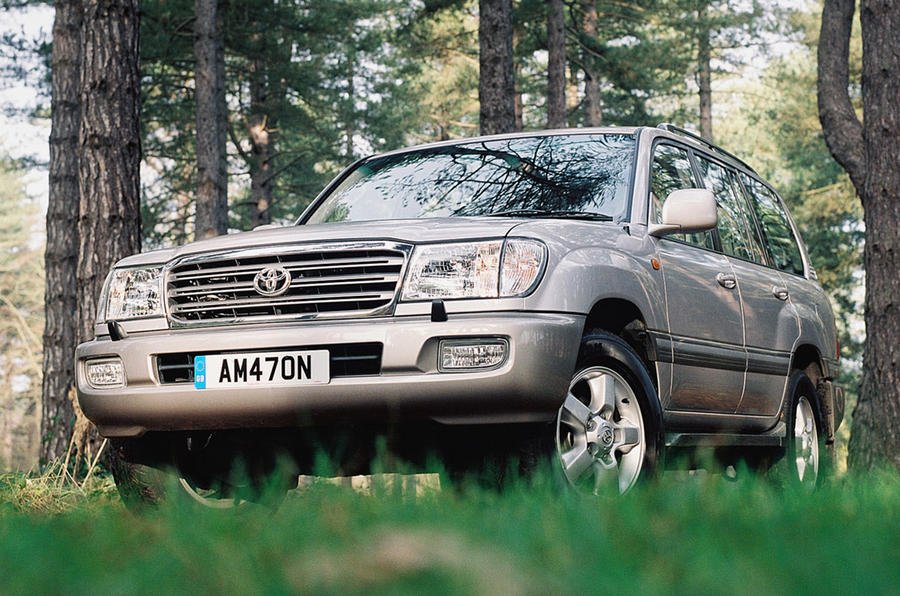Would you pay £11,500 for a 14-year-old Japanese 4x4 with 260,000 miles on the clock? People do. Said 4x4 is the Toyota Land Cruiser Amazon, the supersize Land Cruiser J100 of 1998 to 2007. That price is of the 'asking' variety, of course. We're not sure what it and others like it actually go for, but with rust establishing a toehold (especially on pre-facelift models), the automatic height control (AHC) suspension showing its age and electrical gremlins rife, it has to be lower.
Not by much, though. The Land Cruiser Amazon J100 and its smaller relative, the Land Cruiser J120 of 2002-'09, are admired the world over for their reliability and comfort. They're among the slowest-depreciating cars on the market, the smaller J120 especially so. Being more expensive, less economical and, frankly, a little unnecessary, the larger Amazon depreciated faster from new, but today prices have levelled out. Most people want the diesel version, but if you can afford the fuel bills, the petrol model is better value. Prices for tidy petrols with reasonable mileage and a good history start at around £8000; equivalent diesels cost twice that. An obvious rival is the Range Rover, but how many 14-year-old ones are going strong after 200,000 miles?
Apart from an uprated automatic gearbox, some discreet remapping and in-service technical improvements, the Amazon J100 remained largely unchanged during its near 10-year run. There was a last-minute facelift in 2006, chief among the changes being a new grille; otherwise, a 1998 Amazon isn't much different from one registered six years later. There's the same AHC suspension system, an automatic, self-levelling affair ideal for towing and which also offers a choice of ride-height modes from low to high.
Power outputs are the same, too: 228bhp from the 4.7 V8 petrol and 201bhp from the 4.2 straight-six diesel. In support, the petrol can muster 302lb ft from 3400rpm and the diesel 317lb ft from just 1400rpm. On the road, then, a 2300kg Amazon is satisfyingly quick.
Automatic gearboxes were standard. Initially, it was a three-speed unit with overdrive but from 2004 it grew an extra gear. The diesel was also available with an optional five-speed manual 'box. Today, a manual Amazon diesel is rare and sought after. Inside, seven seats are standard (the rear pair are individual and removable), as are air-con (the higher-grade VX has climate control), cruise control and side steps. Classy touches include heated side windows and powered rear-quarter vents.
Naturally, the Amazon has its problems, detailed on the right, but it is fundamentally a solidly engineered beast built for some of the harshest conditions the planet can throw at it. Fortunately, while it can venture into the loneliest places on earth, thanks to an active and helpful club scene and some great specialist garages, you'll never feel abandoned.
How to get one in your garage
An expert's view
Julian Voelcker, Overland Cruisers: "You don't buy an Amazon for its economy. It's a comfortable, powerful and reliable workhorse. If it's been serviced properly, the engines take high mileages in their stride, but the transmission and suspension get tired. It's not immune to rust, especially at the back along the sills, but if it's not terminal, you shouldn't be put off. You could buy a mechanically sound one for £6000, spend £2000 getting the rust fixed and you'd have an £8000 4x4 that's good for another 10 years. Facelift cars are usefully improved and corrosion should be less advanced."
Buyer beware...
■ Engine: Beware shonky V8 LPG conversions. A smoky diesel will fail its MOT; check its EGR valve hasn't been blanked off. Inspect injector pump for leaks. Petrol and diesel timing belts need changing every 100,000 miles or six years, with the water pump. Oil changes are every 6000. Diesels are noisy from cold but should quieten once warm.
■ Transmission: Pre-facelift auto can suffer torque converter failure. Noises from the front axles as you pull away could be front outer CV joints wearing.
■ Air conditioning: Rumbling or squealing could be the air-con pulley. Check drain pipe isn't dripping, rusting the droplink mount.
■ Suspension, steering wheels and brakes: Cycle through the Automatic Height Control (AHC) settings. A hard, bouncy ride spells trouble, as does a drooping front end. Check the handbrake isn't seized. Wheel bearings need tightening and repacking with grease every 20,000 miles. Look for fluid leaks on underside of power steering pump.
■ Body and chassis: Inspect rear sills and wheel arches, upper tailgate surround and inside edge, and lower tailgate lock surround for rust. If it has towed a boat, the rear chassis may be rotten. Look underneath for off-road grounding.

